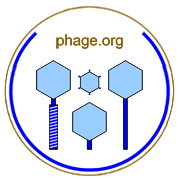

Phage-mediate clearing within a bacterial lawn in which the center is clearer (less turbid) than the outer edges.
Bull's eye plaque form predominantly because phage-induced bacterial lysis is less efficient or complete later on during plaque development than it is early on during plaque development. Decreasing lytic efficiency can be a consequence of aging of the bacterial lawn, associated increases in the size of microcolonies making up the bacterial lawn, or because of less general phenomena such as the lysis inhibition phenotype seen with T-even phages.
Note that bull's eye plaques can contrast with more general plaque turbidity or turbidity that is seen particularly in the centers of plaques rather than around their edges (or, indeed, with clear plaques). General turbidity can be due to the presence of substantial numbers of phage-resistant bacteria within lawns, e.g., as seen with the mixed indicator method.
Plaques with turbid centers are seen especially with where the bacteria forming the center turbidity are microcolonies of bacteria descended from newly formed bacterial lysogens. These microcolonies are larger in the middle because they are
descended from the earliest forming lysogens within these plaques.
For more on this topic, see Wikipedia, Google, and PubMed. Contact web master. Return to terms.